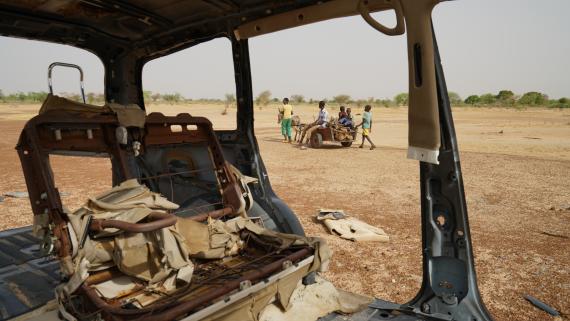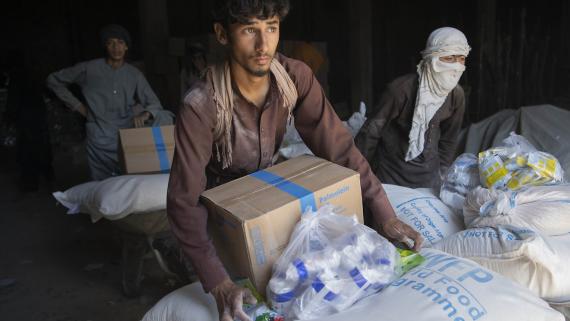Ras Al-Arah, Yemen
A young girl sits in a van after receiving a food basket for her family in Ras Al-Arah. WFP/Saleh Bahulis
The rise of hunger shows no signs of abating. By the end of 2020, the number of acutely food insecure people could increase to 270 million due to COVID-19, representing an 82 per cent increase compared to the number of acutely food insecure people pre-COVID-19. Urgent and sustained humanitarian action is needed to avoid further deterioration and to prevent a risk of famine in areas already on the brink of starvation.
Nearly 690 million people were undernourished in 2019, up by almost 60 million since 2014. Nearly half of all deaths in children under age five are attributable to undernutrition and, regrettably, stunting and wasting still have strong impacts worldwide. In 2019, 21 per cent of all children under age five (144 million) were stunted and 49.5 million children experienced wasting. The effects of the pandemic will increase child hunger, and an additional 6.7 million children are predicted to be wasted by the end of 2020 due to the pandemic’s impact. The situation continues to be most alarming in Africa: 19 per cent of its population is under-nourished (more than 250 million people), with the highest prevalence of undernourishment among all global regions. Africa is the only region where the number of stunted children has risen since 2000. Women and girls represent more than 70 per cent of people facing chronic hunger. They are more likely to reduce their meal intake in times of food scarcity and may be pushed to engage in negative coping mechanisms, such as transactional sex and child, early and forced marriage.
Hunger is risiing

Approximately 1.3 billion people, including 456 million children, suffer from high or extremely high vulnerability to water.
Photo: OCHA
Women and girls represent more than 70% of the people who face chronic hunger.
Photo: WFP

It is estimated that globally, 33% of soils are already degraded, putting food production at risk.
Photo: WFPFunding requirements for food security in humanitarian appeals have steadily increased and almost doubled over the last five years. This worrying trend has grown from $4.7 billion in 2015 to $8.9 billion in 2020.
Conflict is the main cause of acute hunger – 77 million people in 22 countries experienced hunger due to armed violence and insecurity in 2019. Seventy per cent of the top 20 countries at risk of food insecurity are in fragile and conflict-affected situations. Pre-COVID-19 estimates of acute food insecurity in West and Central Africa already indicated a conflict-induced increase for 2020. However, COVID-19’s compounding impact could increase food insecurity in the region by 135 per cent.
Extreme climatic events drove almost 34 million people into food crisis in 25 countries in 2019, 77 per cent of them in Africa. The number of people pushed into food crisis by economic shocks more than doubled to 24 million in eight countries in 2019 (compared to 10 million people in six countries the previous year). Food insecurity is set to get much worse unless unsustainable global food systems are addressed. Soils around the world are heading for exhaustion and depletion. An estimated 33 per cent of global soils are already degraded, endangering food production and the provision of vital ecosystem services.
Sudan: supporting Nutrition in Khartoum
In Sudan, an unprecedented 9.6 million people were severely food insecure and needed urgent assistance by mid-2020. Humanitarian organizations have mobilized to provide nutritional and food assistance to families in Khartoum. In this video, a woman shows how she benefited from access to a nutrition center.
OCHAEvidence from food security assessments and analysis shows that COVID-19 has had a compounding effect on pre-existing vulnerabilities and stressors in countries with pre-existing food crises. In Sudan, an estimated 9.6 million people (21 per cent of the population) were experiencing crisis or worse levels of food insecurity (IPC/CH Phase 3 or above) in the third quarter of 2020 and needed urgent action. This is the highest figure ever recorded for Sudan.
Food security needs are set to increase dramatically in 2021 as the pandemic and global response measures seriously affect food systems worldwide. Entire food supply chains have been disrupted, and the cost of a basic food basket increased by more than 10 per cent in 20 countries in the second quarter of 2020. Delays in the farming season due to disruptions in supply chains and restrictions on labour movement are resulting in below-average harvests across many countries and regions. This is magnified by pre-existing or seasonal threats and vulnerabilities, such as conflict and violence, looming hurricane and monsoon seasons, and locust infestations.
Further climatic changes are expected from La Niña. Forecasters predict a 55 per cent change in climate conditions through the first quarter of 2021, impacting sea temperatures, rainfall patterns and hurricane activity. The ensuing floods and droughts that could result from La Niña will affect farming seasons worldwide, potentially decreasing crop yields and increasing food insecurity levels.
COVID-19 and the risk of famine

The devastating impact of COVID-19 is still playing out in terms of rising unemployment, shattered livelihoods and increasing hunger. Families are finding it harder to put healthy food on a plate, child malnutrition is threatening millions. The risk of famine is real in places like Burkina Faso, north-eastern Nigeria, South Sudan and Yemen.
COVID-19 has ushered hunger into the lives of more urban communities while placing the vulnerable, such as IDPs, refugees, migrants, older persons, women and girls, people caught in conflict, and those living at the sharp end of climate change at higher risk of starvation. The pandemic hit at a time when the number of acutely food-insecure people in the world had already risen since 2014, largely due to conflict, climate change and economic shocks. Acute food-insecurity is projected to increase by more than 80 percent - from 149 million pre-COVID-19, to 270 million by the end of 2020 - in 79 of the countries where WFP works. The number of people in crisis or worse (IPC/CH Phase 3 or above) almost tripled in Burkina Faso compared to the 2019 peak of the food insecurity situation, with 11,000 people facing catastrophic hunger (IPC/CH Phase 5) in mid-2020. For populations in IPC3 and above, urgent and sustained humanitarian assistance is required to prevent a deterioration in the hunger situation. It is alarming that in 2020, insufficient funds left food security partners unable to deliver the assistance required. For example, sustained food ration reductions in Yemen have directly contributed to reduced food consumption since March. Today, Yemen is one of four countries at real risk of famine. OCHA/Giles Clark
OCHA/Giles ClarkFurther reading
Source: FAO / WFP
Source: FSIN / GNAFC
Source: IPC
References
- WFP, Needs analysis informing WFP’s Global Response Plan to COVID-19 – June 2020; Note that the updated June analysis covers 79 countries (all countries with WFP presence, except for DPRK, India, Pacific, Iran and Morocco). The projected 270 million figure is comprised of 149 million people acutely food insecure pre-COVID and 121 million additional people at risk to become food insecure before the end of the year. The 149 million baseline was updated to reflect all newly available data for 2020 and expanded country coverage to all WFP countries where data on acute food insecurity was available.
- FAO, IFAD, UNICEF, WFP and WHO. The State of Food Security and Nutrition in the World 2020. Transforming food systems for affordable healthy diets.
- UNICEF, WHO and the World Bank, Levels and trends in child malnutrition, March 2020.
- World Vision International Out of time: as families’ incomes plummet, millions more children go hungry and are forced to work and beg 2020; Headey, Heidkamp, Osendarp, Ruel, et al. Impacts of COVID-19 on childhood malnutrition and nutrition-related mortality, The Lancet, vol. 396: issue 10250, 22 August 2020
- FAO, IFAD, UNICEF, WFP and WHO, The State of Food Security and Nutrition in the World 2020. Transforming food systems for affordable healthy diets, 2020.
- UNFPA, 10 things you should know about women and the world’s humanitarian crises, 23 May 2016; Girls not Brides and International Centre for Research on Women, Taking action to address child marriage: the role of different sectors – food security and nutrition, 2016.
- OCHA, Financial Tracking Service, Appeals/Plan Overview, data retrieved 25 November 2020. Figures may be higher as they may not include multi-sector assistance.
- Food Security Information Network, Global Report on Food Crises 2020, p.22
- The Famine Action Mechanism (FAM), Emerging Consensus Among FAM Partners Concerning COVID-19 and Food Security Crises, June 2020.
- Primarily linked to conflicts in Central Sahel, northern Nigeria, Central African Republic, and Cameroon. OCHA, Global Humanitarian Response Plan, July Update 2020
- Food Security Information Network, Global Report on Food Crises 2020.
- Food Security Information Network, Global Report on Food Crises 2020.
- FAO and WFP, FAO-WFP Early Warning Analysis of Acute Food Insecurity Hotspots, November 2020.
- WFP, WFP Global Response to COVID-19: September 2020. The cost of a basic food basket has increased by more than 10 percent on top of reduced incomes in twenty countries during the second quarter compared to the first in 2020. The countries are Afghanistan, Angola, Bangladesh, Ghana, Haiti, Honduras, Iran, Kyrgyzstan, Lebanon, Libya, Mauritania, Mexico, Mozambique, Namibia, Nicaragua, Nigeria, Sudan, Syria, Tajikistan and Thailand. Food prices are also exceptionally high in many countries like Syria, Yemen, Lebanon and Zimbabwe.
- OCHA, Global Humanitarian Response Plan, July Update 2020.
- World Meteorological Organization, ENSO and Seasonal Climate Updates, October 2020
- FAO and WFP, FAO-WFP Early Warning Analysis of Acute Food Insecurity Hotspots, November 2020.
- IOM and WFP, Populations at Risk: Implications of COVID-19 for Hunger, Migration and Displacement, November 2020; CARE Some-times We Don’t Even Eat: How Conflict and COVID-19 Are Pushing Millions of People to the Brink, November 2020.
- WFP, Needs analysis informing WFP’s Global Response Plan to COVID-19 – June 2020.
- Food Security Information Network, Global Report on Food Crises Update: In times of COVID-19, September 2020





